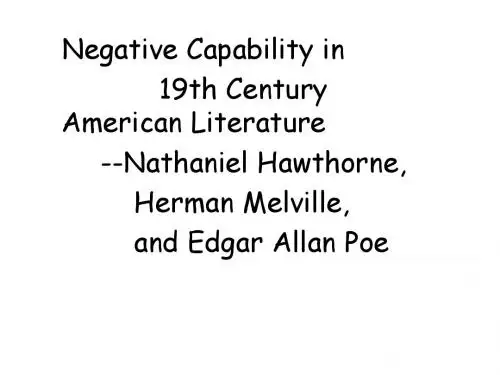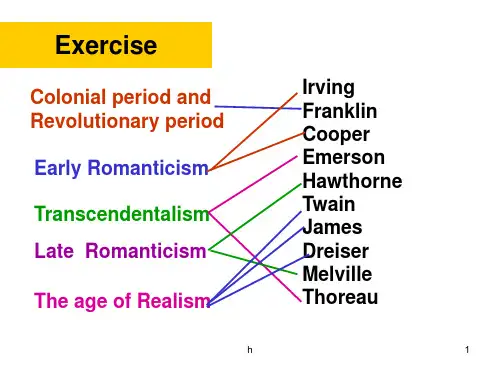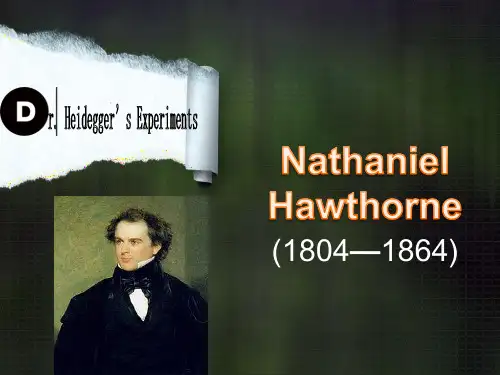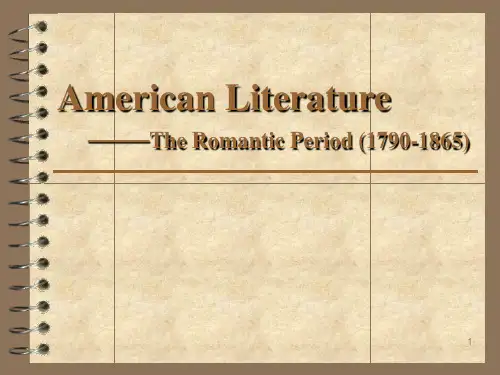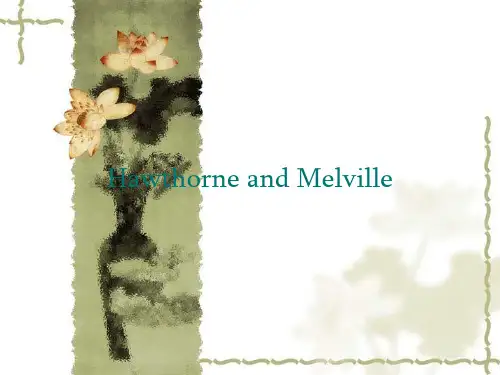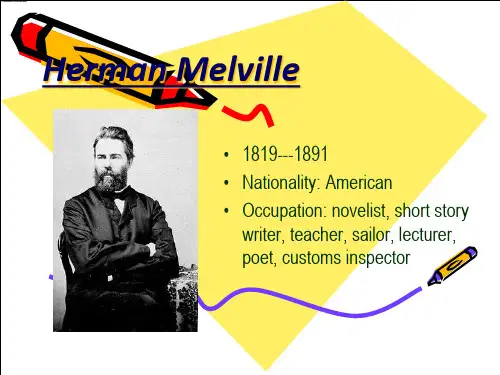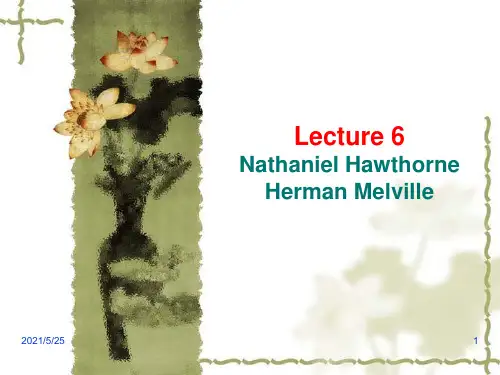- 1、下载文档前请自行甄别文档内容的完整性,平台不提供额外的编辑、内容补充、找答案等附加服务。
- 2、"仅部分预览"的文档,不可在线预览部分如存在完整性等问题,可反馈申请退款(可完整预览的文档不适用该条件!)。
- 3、如文档侵犯您的权益,请联系客服反馈,我们会尽快为您处理(人工客服工作时间:9:00-18:30)。
writing a novel." - N. Hawthorne
21
Hawthorne and American Romance-II
❖ To create "a theater, a little removed from the highway of ordinary travel, where the creatures of his brain may play their phantasmagoric antics, without exposing them to too close a comparison with the actual events of real lives"
3
Boston, MA Setting of The Scarlet Letter
Salem, MA Birthplace of Nathaniel Hawthorne
4
Works of Nathaniel Hawthorne
The Scarlet Letter (1850) The House of the Seven Gables (1851)
The Life of Franklin Pierce (1852) "Chiefly About War Matters" (1862) Our Old Home: A Series of English Sketches (1863) The Whole History of Grandfather's Chair (1840) A Wonder-Book for Girls and Boys (1852)
12
Influences on Hawthorne
❖ 1. Salem - early childhood, later work at the Custom House.
❖ 2. Puritan family background - one of his forefathers was Judge Hawthorne, who presided over the Salem witchcraft trials, 萨 勒姆驱巫案1692. (cf: Arthur Miller:The Crucible 坩埚)
Greek and Roman Influences on Western Literature
20
Hawthorne and American Romance-I
❖ "I have sometimes produced a singular and not unpleasing effect, so far as my own mind was concerned, by imagining a train of incidents in which the spirit and mechanism of the fairyland should be combined with the characters and manners of familiar life." - N. Hawthorne
Tanglewood Tales (1853) 5
Reasons for Hawthorne's Current Popularity
❖ 1. One of the most modern of writers, Hawthorne is relevant in theme and attitude. According to H. H. Waggoner, Hawthorne's attitudes use irony, ambiguity, and paradox.
❖ 2. Hawthorne rounds off the puritan cycle in American writing - belief in the existence of an active evil (the devil) and in a sense of determinism (the concept of predestination).
The Blithedale Romance (1852) The Marble Faun (1860)
Twice-Told Tales (1837, 1851) Mosses from an Old Manse (1846, 1854) The Snow-Image, and Other Twice-Told Tales (1852)
13
❖ 3. Belief in the existence of the devil. ❖ 4. Belief in determinism.
14
Hawthorne as a Literary Artist
❖ 1. First professional writer - college educated, familiar with the great European writers, and influenced by puritan writers like Cotton Mather.
❖ 3. exciting and unexpected chance events;
19
❖ 4. travel to faraway settings; ❖ 5. hidden and mistaken identity; ❖ 6. written in an elaborate and elegant style. ---Gilbert Highet, in The Classical Tradition:
15
❖ 2. Hawthorne displayed a love for allegory and symbol. He dealt with tensions involving: light versus dark; warmth versus cold; faith versus doubt; heart versus mind; internal versus external worlds.
❖ American romancers' use of the frontier, Indian society, Arcadian communities, Puritan villages, and shipboard societies
18
Elements of Classical Romance
16
❖ 3. His writing is representative of 19th century, and, thus, in the mainstream due to his use of nature, its primitiveness, and as a source of inspiration; also in his use of the exotic, the gothic, and the antiquarian.
11
❖ 7. Allegory - Hawthorne's writing is allegorical, didactic and moralistic.
❖ 8. Other themes include individual vs. society, self-fulfillment vs. accommodation or frustration, hypocrisy vs. integrity, love vs. hate, exploitation vs. hurting, and fate vs. free will.
❖ "When a writer calls his work a romance, he
wishes to claim a certain latitude, both as to its
fashion and material, which he would not have felt
himself entitled to assume had he professed to be
17
Romance & American Romanticism
❖ The American Romanticists created a form that, at first glance, seems ancient and traditional; they borrowed from classical romance, adapted pastoral themes, and incorporated Gothic elements
8
❖ 3. Problem of Guilt -a character's sense of guilt forced by the puritanical heritage or by society; also guilt vs. innocence.
❖ 4. Pride - Hawthorne treats pride as evil. He illustrates the following aspects of pride in various characters: physical pride (Robin), spiritual pride (Goodman Brown, Ethan Brand), and intellectual pride (Rappaccini).
7
❖ 1. Alienation - a character is in a state of isolation because of self-cause, or societal cause, or a combination of both.
❖ 2. Initiation - involves the attempts of an alienated character to get rid of his isolated condition.
